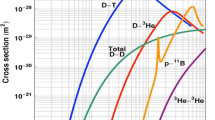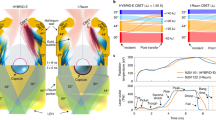Summary
If two features of the inertial-fusion process are exploited success-fully, they can lead to significantly lower costs for demonstrating the feasibility of commercial electric power production from this source of energy. First, fusion capsule ignition and burn physics are independent of reaction chamber size and hydrodynamically equivalent capsules can be designed to perform at small yield, exactly as they do at large yield. This means that an integrated test of all power plant components and feasibility tests of various reaction chamber concepts can be done at much smaller sizes (about 1–2 m first wall radius) and much lower powers (tens of MWs) than magnetic fusion development facilities such as ITER. Second, the driver, which is the most expensive component of currently conceived IFE development facilities, can be used to support more than one experimental target chamber/reactor (simultaneously and/or sequentially). These two factors lead to lower development facility costs, modular facilities, and the planning flexibility to spread costs over time or do several things in parallel and thus shorten the total time needed for development of inertial fusion energy (IEE). In this paper we describe the general features of heavy-ion fusion development plant that takes advantage of upgradable accelerators and the ability to test chambers and reactor systems at small scale in order to reduce development time and costs.
Similar content being viewed by others
References
W. J. Hogan:Small inertial fusion energy (IFE)demonstration reactors, inProceedings of the XIV IEEE/NPSSSymposium on Fusion Engineering, San Diego, Cal., September 30-October 3, 1991, Vol. 1, p. 227.
R. W. Conn, F. Najmabadi, S. Sharafat, K. R. Schultz andR. A. Krakowski:The Requirements of a Fusion Demonstration Reactor and the STARLITEStudy, University of California—LA, UCLA-PPG-1394 (February 1992).
J. J. Barnard et al.:Study of Recirculating Induction Accelerators as Drivers for Heavy Ion Fusion, Lawrence Livermore National Laboratory, UCRL-LR-108095 (September 21 1991).
R. R. Peterson, J. J. MacFarlane andG. A. Moses: CONRAD—A Combined Hydrodynamic-Condensation/Vaporization Computer Code, University of Wisconsin Fusion Technology Institute, UWFDM-670 (July 1980).
R. W. Moir:Fusion Technol.,21, 1475 (1992).
R. F. Bourque, W. R. Meier andM. J. Monsler:Fusion Technol.,21, 1465 (1992) AlsoW. R. Meier et al.: OSIRIS and SOMBREROInertial Fusion Power Plant Designs, W. J. Schafer Associates, WJSA-92-01 (March 1992).
J. H. Pitts:Nucl. Technol. Fusion,4, 967 (1983).
Author information
Authors and Affiliations
Rights and permissions
About this article
Cite this article
Hogan, W.J., Meier, W.R. A lower-cost development path for heavy-ion fusion. Nuov Cim A 106, 1971–1982 (1993). https://doi.org/10.1007/BF02780604
Received:
Accepted:
Published:
Issue Date:
DOI: https://doi.org/10.1007/BF02780604




